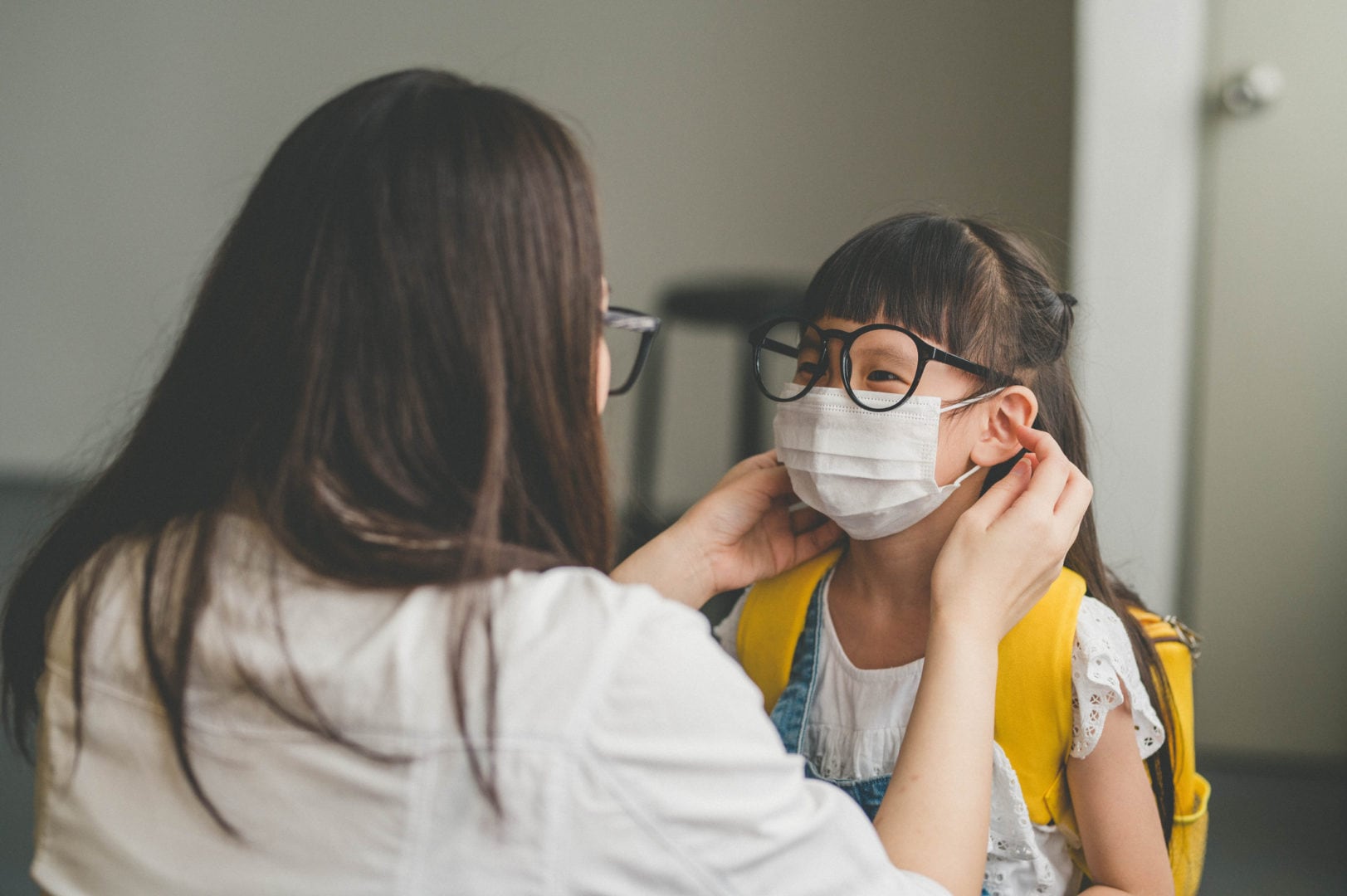When it comes to the 2020-2021 school year, states are anything but united on whether class will resume through distance learning, in-person instruction or through a combination of both. As every state’s education department is setting their own guidance for safely reopening, and local school districts have been given the reins to devise their own game plans, many are opting to bring kids back into the classroom, at least part time. With the COVID-19 pandemic still raging across the country, the potential risks associated with classroom learning are making many parents nervous and fearful.
“Going back to school during COVID-19 sets off parents’ panic, worry and anxiety because there are so many unknowns and so many variables,” says Catherine Richardson, a licensed professional counselor with Talkspace. “Parents want to provide stability for their children, and they feel helpless to do that when so much around them is changing on a regular basis.”
Niro Feliciano, a psychotherapist and anxiety specialist in Wilton, Connecticut, adds, “In essence, this is one big experiment, which can leave parents feeling very uncertain and anxious.”
Thankfully, Richardson, Feliciano and other experts say there are concrete, actionable moves you can make early on this school year to ease anxiety. Here are several effective strategies.
1. Focus on what you already know
When contending with any panic-inducing situation, it’s best to lean into knowledge and facts over fear. That said, don’t forget the power of three main, CDC-recommended safety precautions: hand-washing, physical distancing and wearing masks when you can’t maintain a distance of six feet.
It can also help to focus on consistent risk reduction efforts made by you, your child and your child’s school. While transmission can occur in a variety of scenarios, contracting COVID-19 generally requires sustained contact with an infected person to become ill, says Dr. Lea Lis, a double board-certified adult and child psychiatrist and author of “No Shame: Real Talk With Your Kids About Sex, Self-Confidence, and Healthy Relationships.” “Walking by an infected person briefly usually will not cause enough of a viral load for transmission,” she notes. “Furthermore, depending on where you live, and if there are lower levels of COVID in your community, then the chances of coming into contact with an infected person go down significantly.”
2. Gather pertinent information
Given that the unknown — especially in regard to how your child’s school district plans to implement safety protocols — only serves to fuel nervousness, Richardson recommends that parents do a bit of networking.
“Before problems arise, build a positive rapport not only with your child’s teacher but also the school administration,” she says. “Vice principals, school secretaries and guidance counselors are helpful resources in learning how and why the school functions the way it does. Make it a point to get to know these people, so that when you have a problem to voice, a positive foundation has already been built.”
Irene Little, a doctor of psychology from Frisco, Texas, adds, “Parents can ask the principals for videos and photos of safety protocols. They can ask for Zoom meetings with the teacher to ask about safety features and assurances. This could also be a great time to reach out to other parents — create a support group on Facebook.”
In other words, feel free to gather details about your school district’s plan, says Lynn Burrell, a Manhattan Beach, California-based school psychologist and co-founder of Weldon, a parent coaching service. As better understanding expectations can help reduce anxiety, she recommends parents get specifics on the most critical COVID-19 safety precautions being taken at your school:
-
The policy on mask-wearing.
-
The hand-washing schedule — and if the school is able provide adequate supplies.
-
The plans and procedures for physical distancing (during recess/breaks, lunch and hallway transitions between classes or rooms)
-
The schedule for cleaning and sanitizing.
3. Step up mindful communication with your child
It’s natural to want to dig for details on your child’s school day, as a thumbs-up on feeling safe could offer peace of mind. But the strategy you choose to cull that info is key — for your anxiety and your child’s. “Constant questioning of the kids as soon as they walk in the door might only increase stress and put strain on the parent-child relationship,” notes Feliciano.
Try to be mindful of how often you are asking the same questions, as well as how you’re framing your queries. “Open-ended questions are better to foster a healthier connection,” says Feliciano. “For example: ‘How did today go?’ ‘How did you feel today at school?’ ‘What did you enjoy today?’ ‘Did anything happen that was hard or that you didn’t like today?’”
4. Hold onto what you can control
While it might feel like the unknowns outweigh the knowns, Beth Derickson, a licensed clinical social worker with Talkspace, urges parents to focus not only on the information that they do have but the aspects of the situation they can control — now or down the road.
She offers a tip for refocusing on what you can control: “Draw three circles on a piece of paper and label them ‘things I can control,’ ‘things I can’t control’ and ‘things I have some influence on,’” she notes. “We can control if we wear a mask, how often we wash our hands. We don’t control other people’s children or how they handle the virus. We might have some influence by telling people how we feel or what our opinions are, but we can’t control their actions.”
It’s also important to remember that while this moment might feel especially heavy and slog-like, it’s impermanent. “It will not last forever,” notes Feliciano.
5. Expect and prepare for rule-breaking
Anxiety might be stemming from a variety of unanswered questions, such as, “What happens if another child isn’t wearing their mask on the bus?” or “What if another child touches my child in the hallway between classes?” Assuming that rulebreakers (and aren’t most kids rulebreakers or at least rule forgetters at times?) will inevitably pop up can actually quell your fears, says Feliciano. “Just expect that it will happen,” she says.
Then, focus on practicing healthy hygiene habits at home — which will inevitably roll into their school days — and devising game plans for kids to lean on should they notice rule-breaking. “Have conversations with your kids to help them identify these situations and what they should do or say in case they run into these scenarios,” says Feliciano. “It’s important we help them identify that they can move to another location, wash their hands or use hand sanitizer.”
Giving them the language is important, as well. For example, go over responses they can use, such as, “Could you please pull your mask up over your nose — or it won’t work” or “Can you move back a few steps so that it’s safer for both of us?”
6. Get involved
Feeling empowered might very well be the antidote to anxiety. For that reason, consider taking actions that can make an impact or will at least make you feel heard. “If you feel that there are more effective ways to navigate returning to school, become empowered to be a shareholder in the process,” suggests Jason Woodrum, a certified social worker and therapist at New Method Wellness in San Juan Capistrano, California. “Use this as a chance to become more involved in an organization like a PTA, or find ways to advocate on behalf of safety measures such as school board hearings. In doing so, you can get a greater sense of the necessary safety measures in place in order to soothe your fears over your child’s return to school or be able to have a positive impact on your community by advocating for additional measures that are not currently on the table.”
Feliciano advises banding together with like-minded parents. “You can address the system together, which is often more effective,” she says. “Gather information, talk with other parents to verify and then, take the appropriate steps to discuss the situation with the school.”






